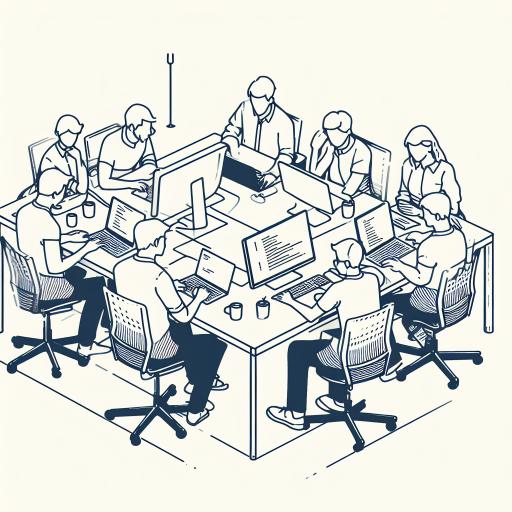How do we provide Software Testing and Quality Assurance?
Code Guardians: Elevating Quality Assurance to Uncharted Heights
At Autoom Studio, we are committed to excellence in Software Testing and Quality Assurance, ensuring that your software products not only meet but exceed industry standards. With a team of seasoned Software Testers and QA Engineers, we bring a wealth of experience in Test Case Design, Manual Testing, Automation Testing, Programming Skills, Defect Tracking, and Collaboration Tools. Our mission is to be your trusted partner in delivering flawless software that drives success for your business.
What is Software Testing and Quality Assurance?
Software testing involves systematically evaluating a software application to identify and rectify defects, ensuring it behaves as expected and meets specified requirements through various testing types like unit, integration, and system testing. Quality Assurance (QA) is a broader concept focused on the entire software development process, emphasizing process improvement, adherence to standards, and proactive measures to prevent defects. QA ensures the effectiveness and efficiency of the development lifecycle, aiming for high-quality software by implementing guidelines, conducting audits, and continuously refining processes. Together, software testing and QA contribute to the delivery of reliable, error-free software products. Let’s break down each concept:
Software Testing:
- Systematically evaluates software applications or systems.
- Identifies and fixes defects or issues.
- Ensures software behaves as expected and meets requirements.
- Involves executing software under controlled conditions.
- Types include unit testing, integration testing, system testing, acceptance testing, etc.
- Helps uncover defects early, reducing costs and improving software quality.

Quality Assurance (QA):
- Encompasses the entire software development process.
- Ensures processes, methods, and standards are followed.
- Focuses on process improvement, standards, and guidelines.
- Involves audits and reviews to identify areas for improvement.
- Aims to prevent defects and ensure high-quality software.
- Not limited to testing but involves proactive management of the development lifecycle.
How do Software Testing and Quality Assurance contribute to Business Success?
Software Testing and Quality Assurance (QA) play pivotal roles in contributing to business success by ensuring the delivery of high-quality software products. Here are several ways in which they contribute:

Customer Satisfaction:
Rigorous testing and QA processes help identify and fix defects before software is released, reducing the likelihood of customers encountering issues. This leads to increased customer satisfaction as users experience reliable and bug-free software.

Cost Savings:
Early detection and resolution of defects during the testing phase are more cost-effective than addressing issues later in the development lifecycle or, worse, after the software is released. This contributes to cost savings by minimizing post-release maintenance and support efforts.

Time-to-Market:
Efficient testing and QA processes streamline the development lifecycle, reducing the time required to release software. Faster time-to-market is crucial for staying competitive in rapidly evolving markets and meeting customer expectations.

Brand Reputation:
Consistently delivering high-quality software builds a positive brand reputation. Users are more likely to trust and recommend products from companies known for their reliable and well-tested software.


Risk Mitigation:
Testing and QA help identify and mitigate risks associated with software development. By proactively addressing potential issues, such as security vulnerabilities or performance bottlenecks, businesses can avoid negative consequences and safeguard their operations.

Optimized Resource Utilization:
QA practices, including process improvement and adherence to standards, contribute to optimized resource utilization. Efficient development processes result in better use of time, manpower, and other resources.

Continuous Improvement:
QA is not a one-time activity; it involves continuous improvement of processes. Regular assessments, audits, and feedback loops contribute to ongoing refinement, making the development process more efficient and effective over time.

Competitive Advantage:
Businesses that prioritize software quality gain a competitive advantage. High-quality software distinguishes a company in the market, attracting more customers and establishing it as a leader in its industry.
Our Services
1. Test Case Design: Precision in Every Line of Code
Our expert Test Case Design ensures comprehensive coverage, leaving no stone unturned. We meticulously craft test cases to validate functionality, performance, security, and usability, ensuring that your software stands up to the demands of the real world.
Key Points:
- Tailored Scenario Creation: Each test case scenario is meticulously tailored to reflect the specific requirements and functionalities of your software, guaranteeing a thorough examination.
- Rigorous Methodologies: We employ rigorous testing methodologies, including boundary value analysis, equivalence partitioning, and decision table testing, to achieve maximum coverage and pinpoint potential vulnerabilities.
- Adaptive Refinement: Our process is dynamic, adapting to the evolving needs of your project. Continuous refinement ensures that our test cases remain relevant and effective throughout the software development lifecycle.


How We Work:
- Requirements Analysis: We start by conducting a detailed analysis of your software requirements. Understanding the intricacies of your project allows us to design test cases that align with your specific goals.
- Collaborative Workshops: Our team engages in collaborative workshops with your development and business teams. These sessions ensure that all stakeholders are on the same page, fostering a shared understanding of the software functionality.
- Traceability Matrix: We create a traceability matrix to link each test case back to the specific requirements it addresses. This ensures that our testing efforts are thorough and that no requirement goes unverified.
2. Manual Testing: The Human Touch for Unparalleled Quality
In an era dominated by automation, our Manual Testing stands out for its human-centric approach. Our experienced testers bring intuition, creativity, and real-world insights to the testing process, ensuring a comprehensive evaluation of your software’s user experience.
Key Points:
- Skilled Manual Testers: Our manual testing team comprises skilled professionals with years of experience, ensuring a keen eye for detail and a deep understanding of user behavior.
- User-Centric Testing: We focus on the end-user experience, identifying potential pain points and areas of improvement to guarantee a seamless and intuitive user interface.
- Usability Analysis: Our manual testing process includes in-depth usability analysis to ensure your software not only functions flawlessly but also provides an optimal user experience.


How We Work:
- Test Planning: We meticulously plan our manual testing process, considering the scope of testing, test scenarios, and testing environments. This planning phase ensures that our manual testing efforts are strategic and efficient.
- Exploratory Testing: Besides scripted testing, our manual testers perform exploratory testing to simulate real-world user interactions. This approach allows us to uncover unexpected issues and enhances the overall quality of your software.
- Usability Testing Workflows: Our manual testing includes dedicated usability testing workflows, evaluating the software from an end-user perspective. This involves assessing the user interface, navigation, and overall user experience.
3. Automation Testing: Speed, Efficiency, and Precision
Harness the power of automation to accelerate your testing processes. Our Automation Testing services leverage cutting-edge tools and frameworks to deliver rapid, repeatable, and reliable results, empowering your team to focus on innovation.
Key Points:
- Scripted Efficiency: We create automated test scripts that not only expedite the testing process but also provide reliable and repeatable results, ensuring consistent software performance.
- CI/CD Integration: Our automation solutions seamlessly integrate with continuous integration/continuous deployment (CI/CD) pipelines, allowing for quick identification and resolution of issues throughout the development cycle.
- Customized Solutions: Every project is unique, and so are our automation solutions. We tailor our approach to fit your specific needs, ensuring the most efficient and effective automation strategy.


How We Work:
- Tool Selection: We begin by Automation tool Development carefully selecting automation testing tools and frameworks based on the specific requirements of your project. Our team ensures that the chosen tools align with your technology stack and testing goals.
- Script Development: Our skilled automation engineers develop robust test scripts that cover critical functionalities. These scripts are designed for efficiency, repeatability, and reliability, forming the backbone of our automated testing approach.
- Continuous Integration: Automation testing is seamlessly integrated into your CI/CD pipeline, ensuring that tests are executed automatically with each code change. This integration facilitates early detection of defects and accelerates the development cycle.
4. Programming Skills: Bridging the Gap Between Development and Testing
Our team of QA Engineers possesses strong programming skills, ensuring seamless collaboration with your development team. This synergy results in quicker issue resolution, efficient communication, and a smoother development lifecycle.
Key Points:
- Multilingual Proficiency: Our QA Engineers are proficient in multiple programming languages, allowing for effective collaboration and understanding of the development process.
- Collaborative Problem Solving: We work closely with developers to bridge the gap between testing and development, enabling swift issue resolution through collaborative problem-solving approaches.
- Code-Level Understanding: Our in-depth understanding of code allows us to identify potential issues at the source, minimizing debugging time and enhancing overall software quality.


How We Work:
- Collaborative Coding: Our QA Engineers collaborate closely with your development team, participating in code reviews and discussions. This collaborative coding approach enhances communication, leading to faster issue resolution.
- Pair Programming: In some cases, our QA Engineers engage in pair programming sessions with developers. This hands-on approach fosters a deeper understanding of the codebase and accelerates the identification and resolution of issues.
- Knowledge Transfer Workshops: We conduct knowledge transfer workshops to share testing insights with developers and vice versa. This ensures that both teams are well-informed about each other’s work, fostering a collaborative and efficient working relationship.
5. Defect Tracking: Swift Identification and Resolution
Effective defect tracking is at the core of our quality assurance process. We employ robust defect tracking tools and methodologies to identify, prioritize, and resolve issues promptly, preventing potential roadblocks in your project timeline.
Key Points:
- Transparent Reporting: We provide transparent and real-time defect tracking, offering detailed reports that include the severity and impact of each identified issue.
- Prioritization Excellence: Our team prioritizes defects based on their severity and potential impact on the project, ensuring that critical issues are addressed promptly to maintain project timelines.
- Continuous Monitoring: Defect tracking is not a one-time process for us. We continuously monitor and manage defects throughout the development lifecycle, providing a proactive approach to issue resolution.

How We Work:
- Centralized Defect Tracking: We employ centralized defect tracking tools that provide a transparent view of identified issues. This centralized approach ensures that all team members have real-time access to the status and progress of defect resolution.
- Severity-Based Prioritization: Defects are prioritized based on severity and potential impact on the project timeline. This ensures that critical issues are addressed promptly, preventing delays in the software development lifecycle.
- Root Cause Analysis: For each defect, our team performs a thorough root cause analysis to understand the underlying issues. This analysis informs our defect resolution strategies and helps prevent similar issues in the future.
6. Collaboration Tools: Streamlined Communication for Success
Communication is key to successful project delivery. We utilize collaboration tools that facilitate seamless communication among team members, ensuring everyone is on the same page and project progress is transparent.
Key Points:
- Integrated Workflows: We seamlessly integrate collaboration tools into the testing workflow, ensuring that communication is a natural part of the development process.
- Real-Time Updates: Our collaboration tools provide real-time updates and reporting, offering enhanced transparency into project progress, testing results, and issue resolution.
- Efficient Channels: We establish efficient communication channels for quick issue resolution, allowing for swift collaboration between team members and stakeholders.


How We Work:
- Tool Integration: Collaboration tools are seamlessly integrated into our testing workflow, allowing for real-time communication and collaboration. This integration ensures that all team members are on the same page regarding project status and updates.
- Regular Meetings: We conduct regular team meetings and status updates to facilitate open communication. These meetings provide an opportunity to discuss progress, address concerns, and align everyone with project goals.
- Issue Resolution Channels: Our collaboration tools include dedicated channels for issue resolution. This streamlined approach ensures that any communication regarding defects, challenges, or updates is efficiently channelled for quick resolution.
About
“Empowering businesses with cutting-edge automation solutions, we are dedicated to delivering seamless business automation. Unleash the power of innovation, enhance productivity, and thrive in the competitive landscape with our bespoke solutions. We specialize in revolutionizing businesses through automation. Experience a seamless integration of technology and efficiency as we propel your enterprise to new heights.”
Quick Links
© 2024 Autoom Studio. All Rights Reserved.
